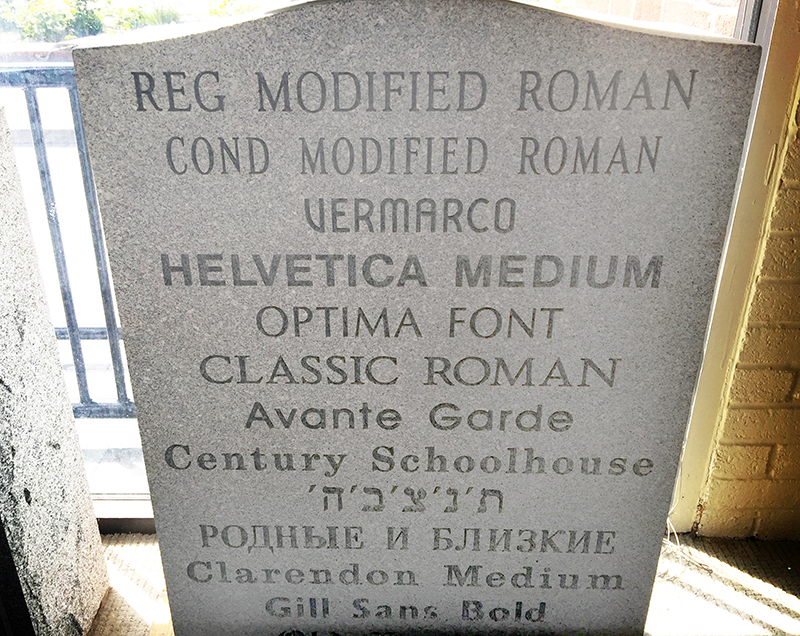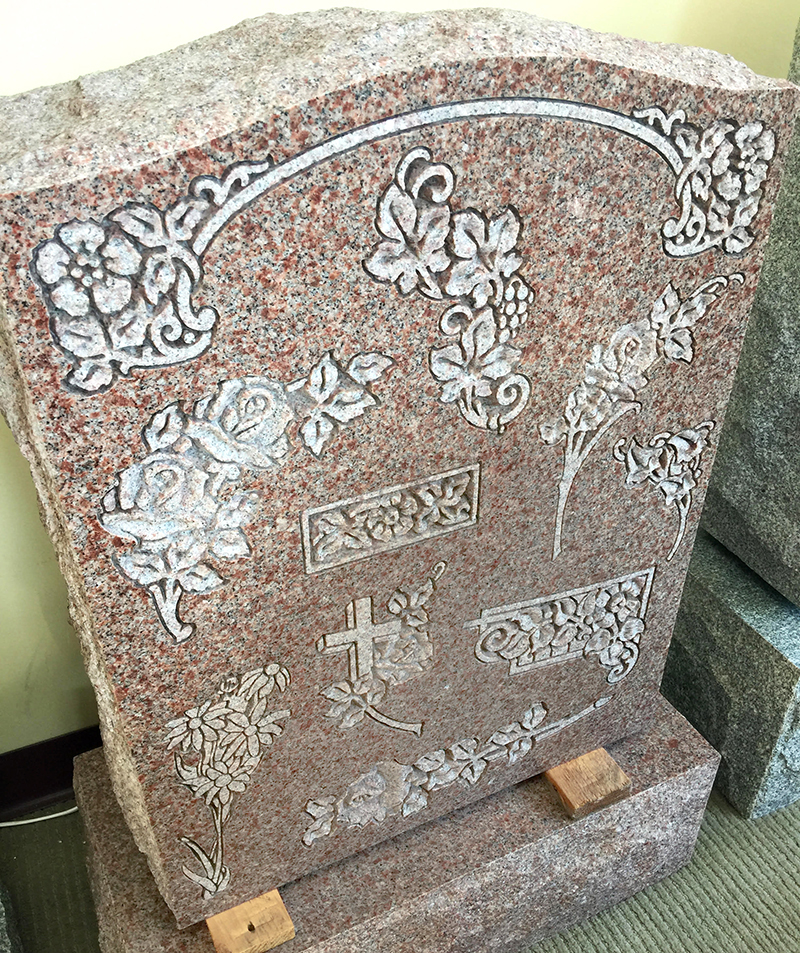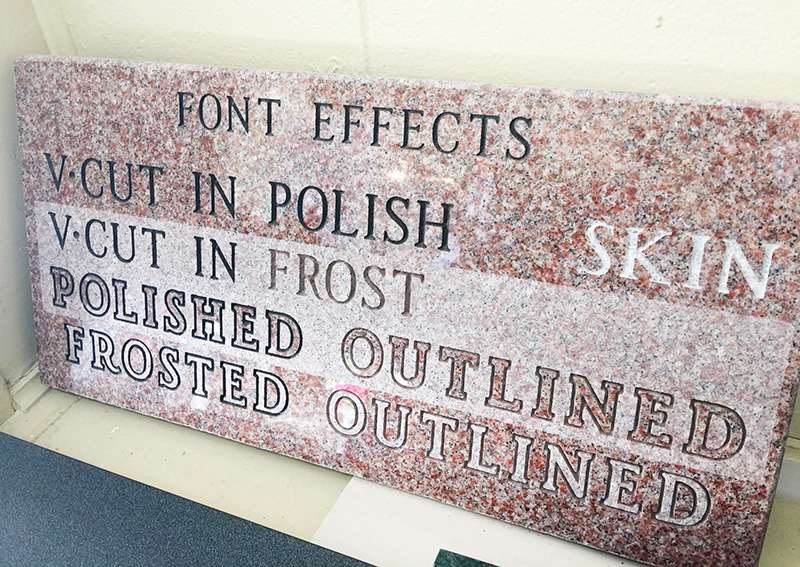
Photo: Thomas Greb and Jason Stark
Tombstone creation, with its centuries of history, is perhaps one of the most enduring forms of graphic design. Design Observer editor Maya P. Lim interviewed Thomas Greb and Jason Stark (CFO) at Slotnick, Canter, Schneider Memorial Group to learn about the art and design of tombstones.
Maya P. Lim: What’s the process of engraving a tombstone?
Thomas Greb: The process begins with a CAD mapping, where we digitally plot out the lettering, lines, and a sketch of custom designs the family wants on the stone.
Once mapped, we begin the actual carving. First, we lay a rubber stencil over the surface of the stone (all our stone is granite). A CNC machine pre-cuts the lettering on the stencil, and it gets glued down. Then, each letter is peeled away. All lines, flowers, or emblems are hand cut by our stone designer.
Then, we roll the stone into a huge sand blasting room. Here we use a high-powered hose that shoots out gritty material over the stone, carving away the areas that were cut out from the rubber.
After we’re done blasting, you peel back all the rubber from the stone. More detailed work is done separately.
MPL: What do you mean by detailed work?
TG: Decorations that go on the tombstone. Such as flowers. Typical flowers are fairly 2D and only need a small amount of “shaping.” Shaping is when you take the stone into a separate, smaller area and use pressurized small metal beads to warp the stone.
But making roses is the true art of tombstone-making, in my opinion. They require extensive training because it takes a combination of both blasting and shaping, and you need to work at extreme angles to create a near 3D shape inside the stone.

Photo: Thomas Greb and Jason Stark
MPL: What about fancy type effects, like outlining?
Jason Stark: Outlining is certainly requested, though not very often. We do a very cool outlining design where the outside of the outlines remains polished, then we frost the inside of the lettering. Frosting is when you move the blaster really quickly over the stone. Fast enough so you don’t make any major carved into the stone but slow enough to remove the dark polish. When done correctly you create a beautiful contrast that’s perfect for putting the dark lettering inside.
MPL: How has the process of making tombstones changed over the years? Are there trends in tombstone design?
JS: You’d have to go back about 50 years to see significant changes in design. It all stems from use of the computer. Back then, each letter was chiseled away by hand without the use of computer design or sand blaster. This led to much more intricate designs, and emblems. Nowadays, the fonts are standardized computer fonts and the emblems have gotten less complex. This could be because people often want a simpler and more traditional stone, or possibly because of the amount people can afford to spend is decreasing.
MPL: How about the size of the stone?
JS: The size of the stone has also shrunk (possibly also because of costs). However, you’re seeing more and more stand up stones. In the past there were more “markers,” which are stones that are flush with the ground. Now we’re seeing much more of the stand up stones that you normally think of when you hear the word “tombstone.”
MPL: I imagine that in the past, wealthier people had more ornate tombstones. Where have you seen the most beautifully designed tombstones?
TG: There are some incredible stones carved in the Boston area, the mausoleum type ones for the wealthy are especially impressive. However, the most beautiful work I’ve seen was actually in Yunnan province in southern China. I saw an absolutely massive gravestone that had hundreds upon hundreds of Chinese characters, all chiseled by hand (no sandblasters back then).
MPL: Have you seen any particularly weird tombstones? Like ones that completely went beyond the typical rectangular block with centered lettering?
TG: We’ve made some pretty unique ones, like stones shaped as full sized motorcycles. But those are very rare because most cemeteries have rules about what you can use. More common is adding unique emblems to the stone that break from tradition. We’ve created tattoo replicas, laser etches of faces, and hand-drawn nature scenes that have come out amazing.
MPL: Tell me more about the typefaces. What are the most common ones in your shop?
JS: Condensed/Modified Roman is the font we use most often now, but Optima and Classic Roman are also fairly popular.

Photo: Thomas Greb and Jason Stark
MPL: How about script faces? Are they much harder to form?
TG: We usually have a cursive script at the bottom of stones for the epitaph, though most scripts faces are difficult to blast. The skinny ends of the lettering often cause problems with the glue and blaster.
MPL: Do people ever request specific typefaces on their tombstones from your group? If I wanted Bodoni, for example, could you do that for me?
TG: You know, for the past 10 years I’ve been keeping a list of what various friends would put on their stone, but never have I had any requests for typefaces. We usually stick to a few default typefaces because of the rubber cutting machine and blasting. Fonts with skinny lines are usually unusable because we can’t blast in between them.
MPL: Rats. I guess that means I can't go around saying, “Not over my dead Bodoni!”
